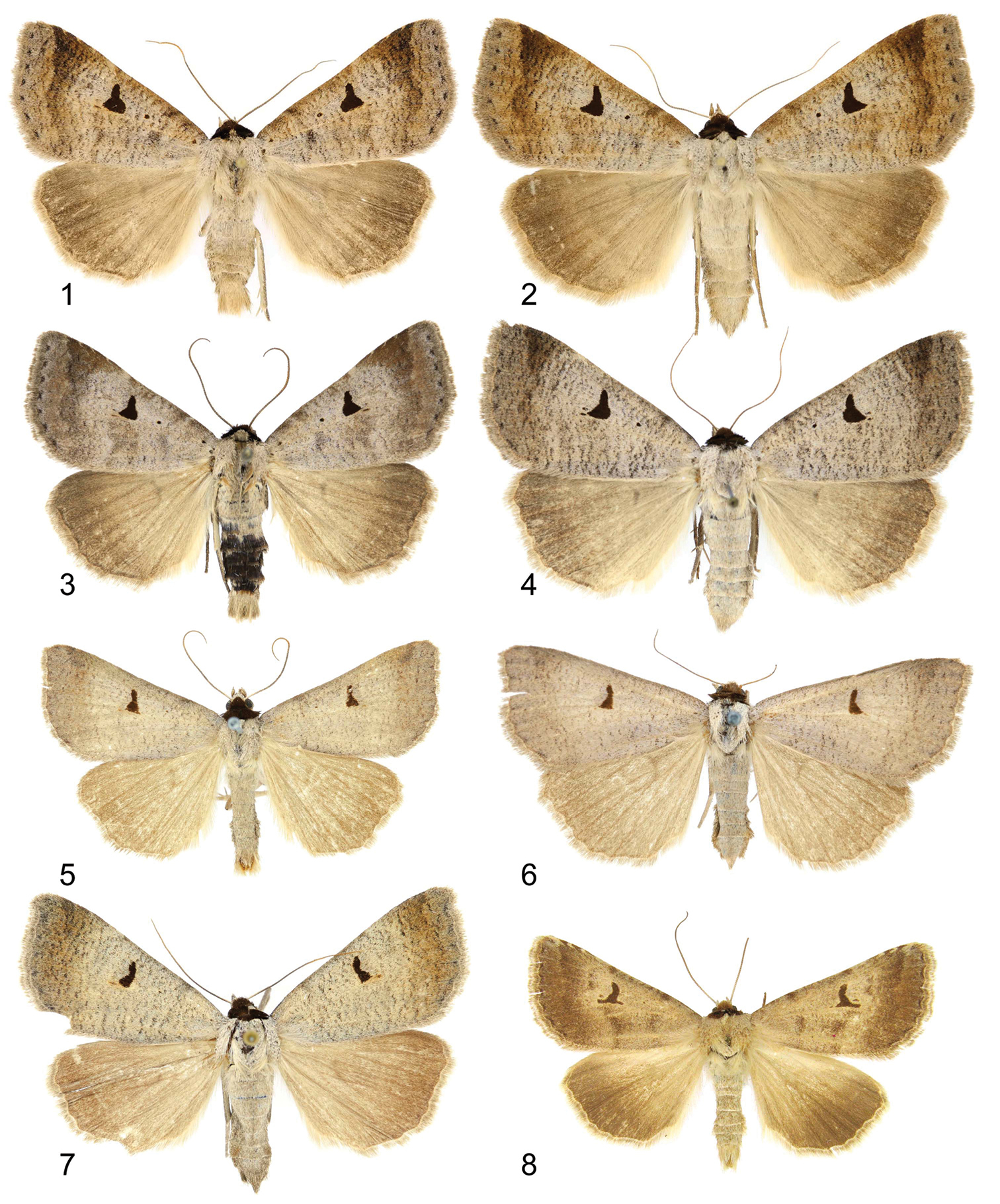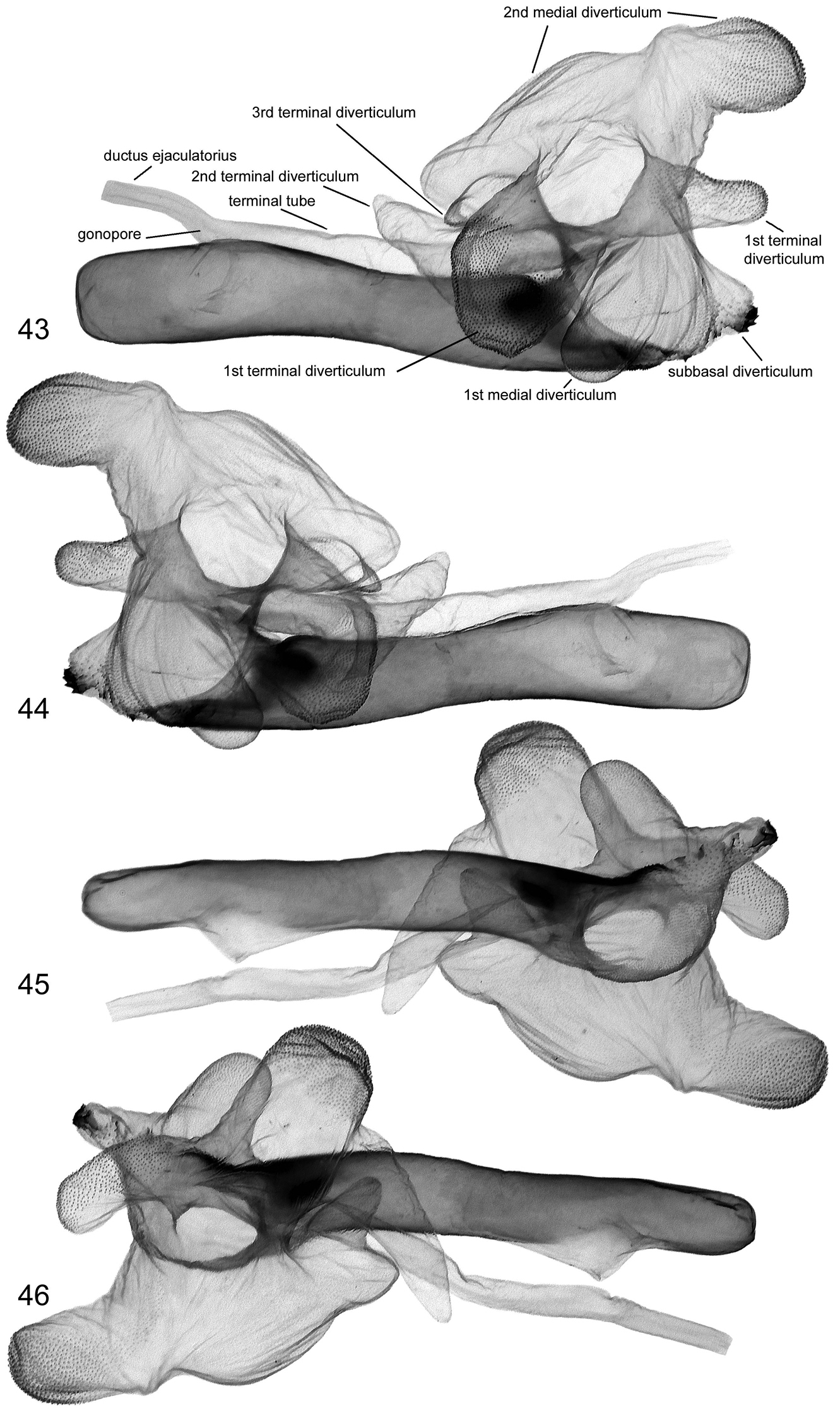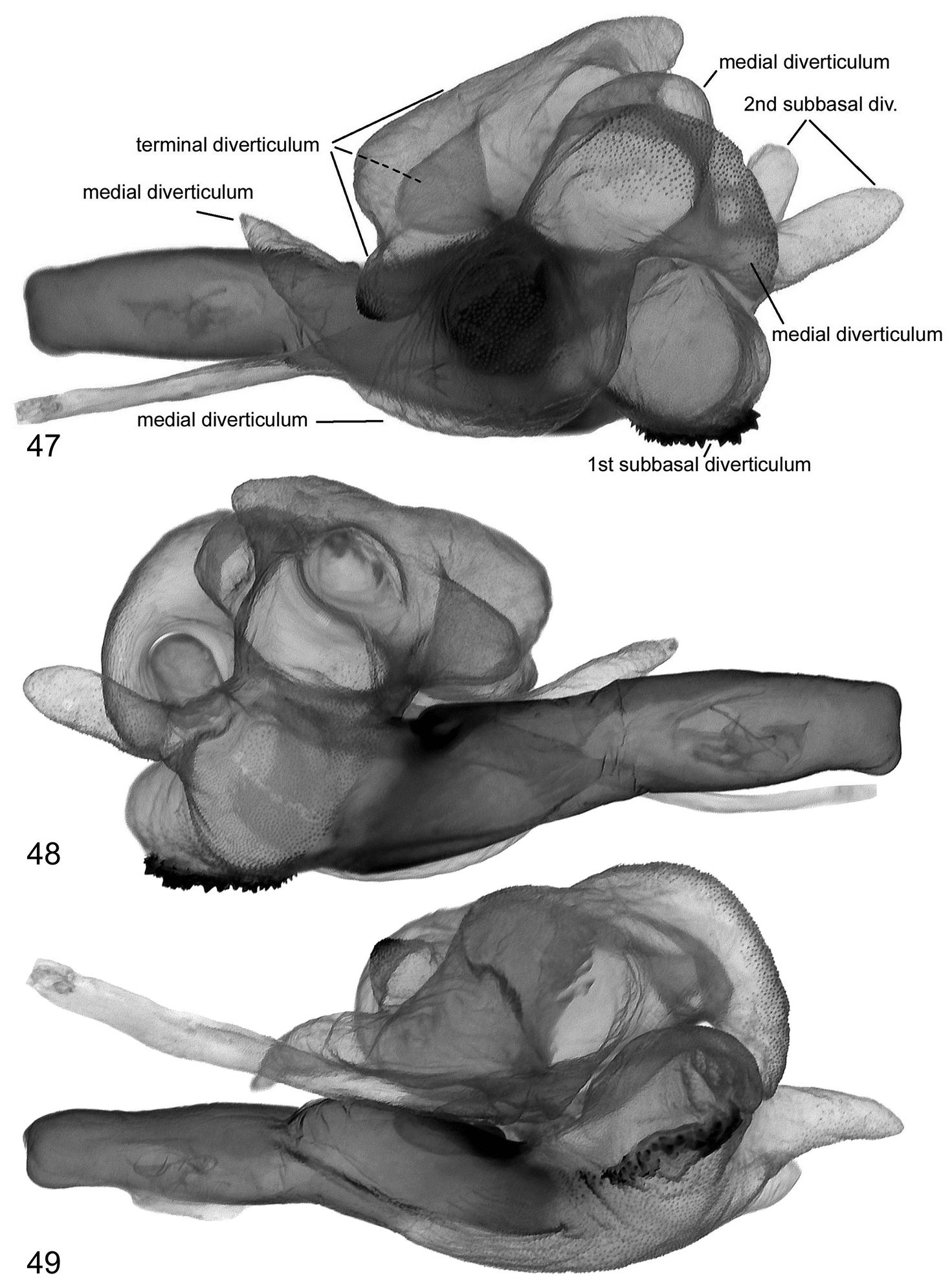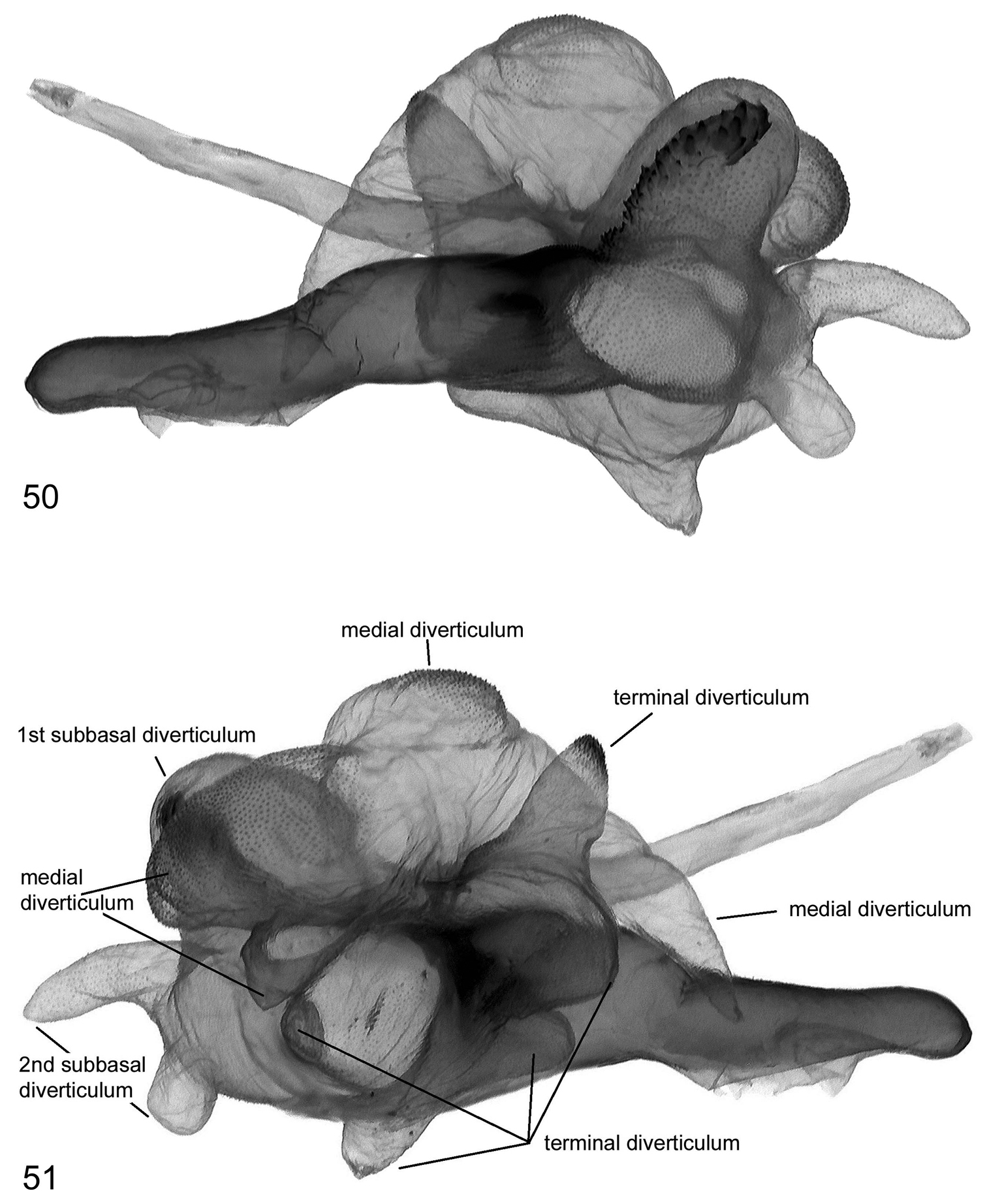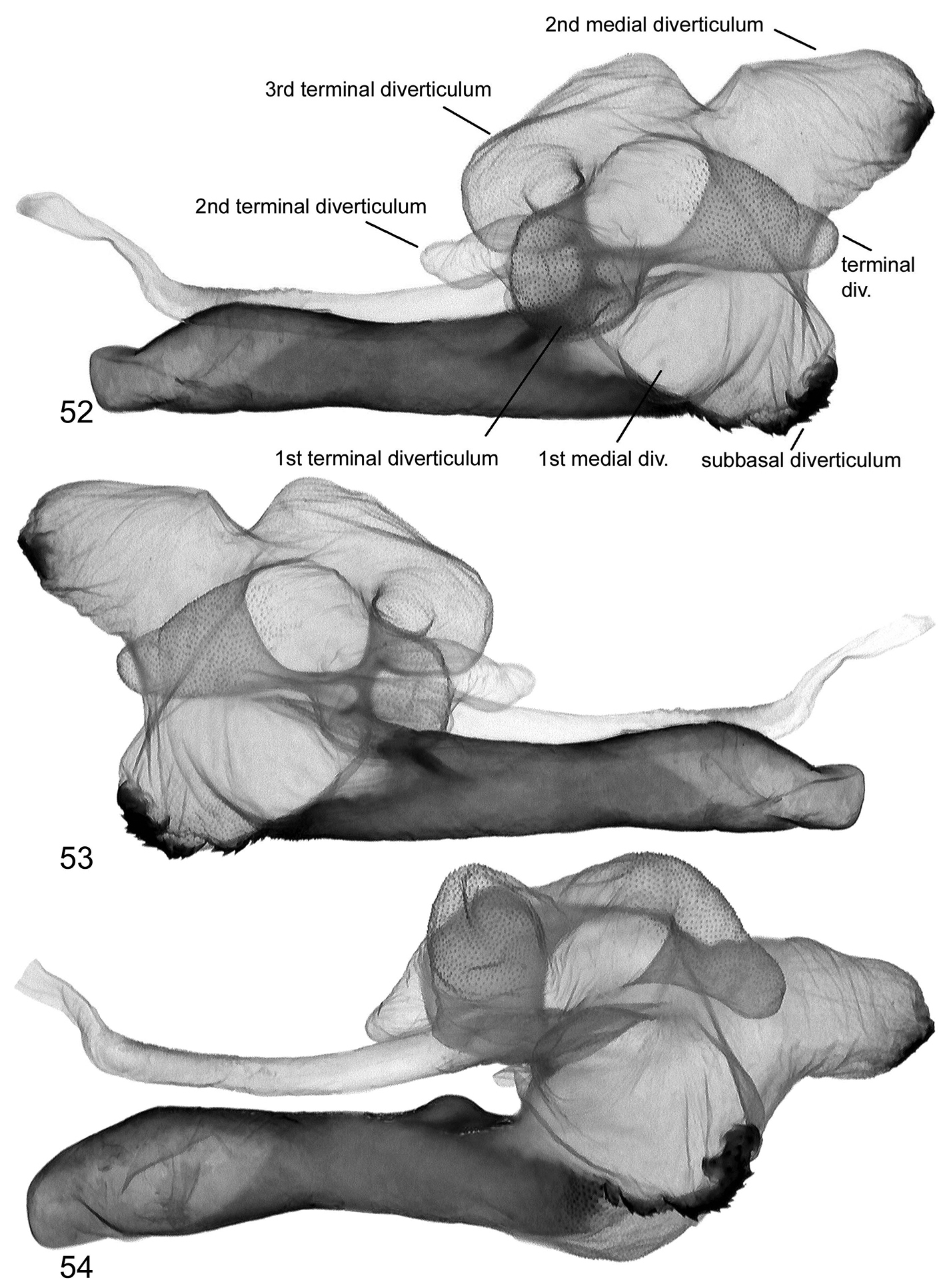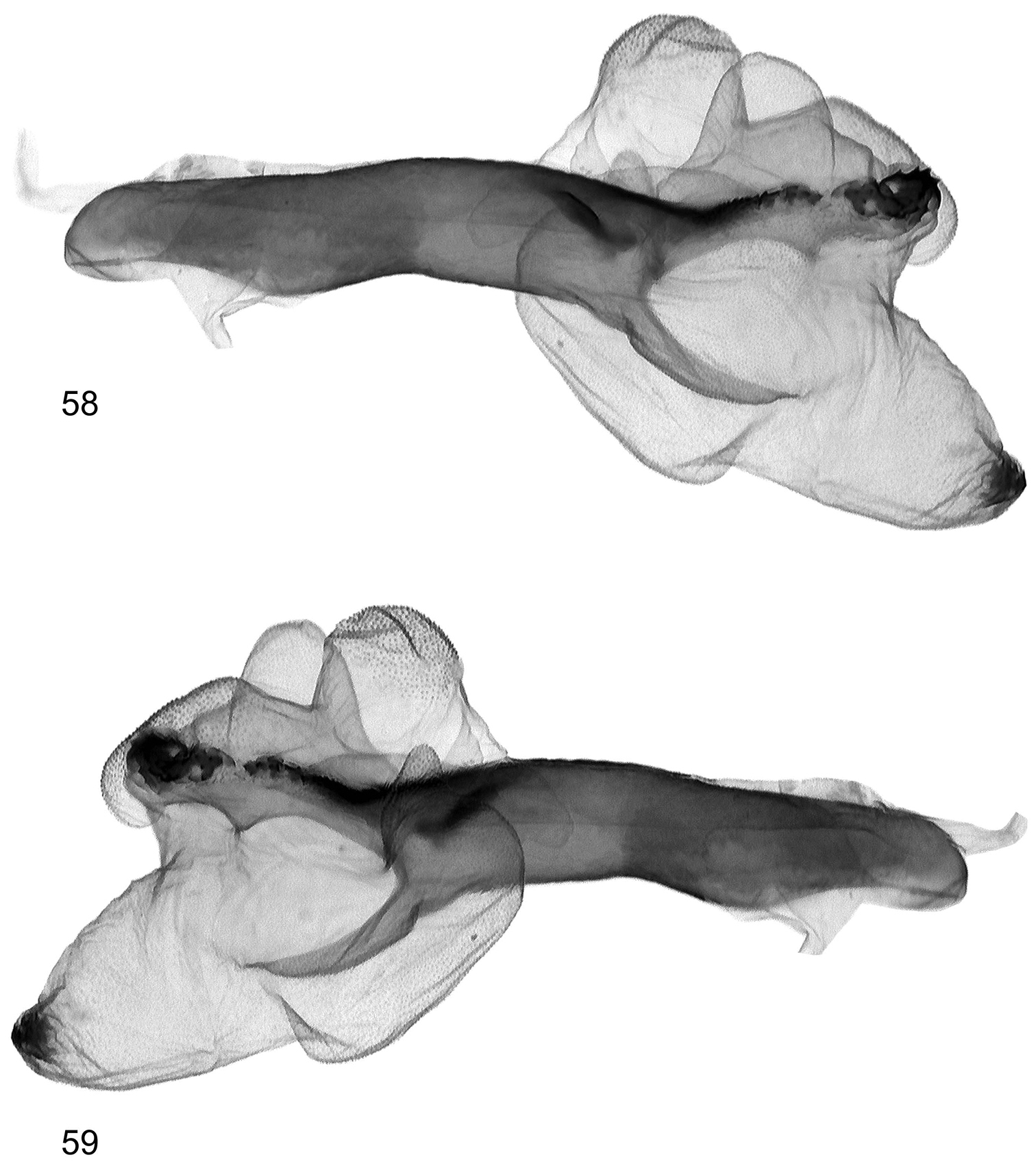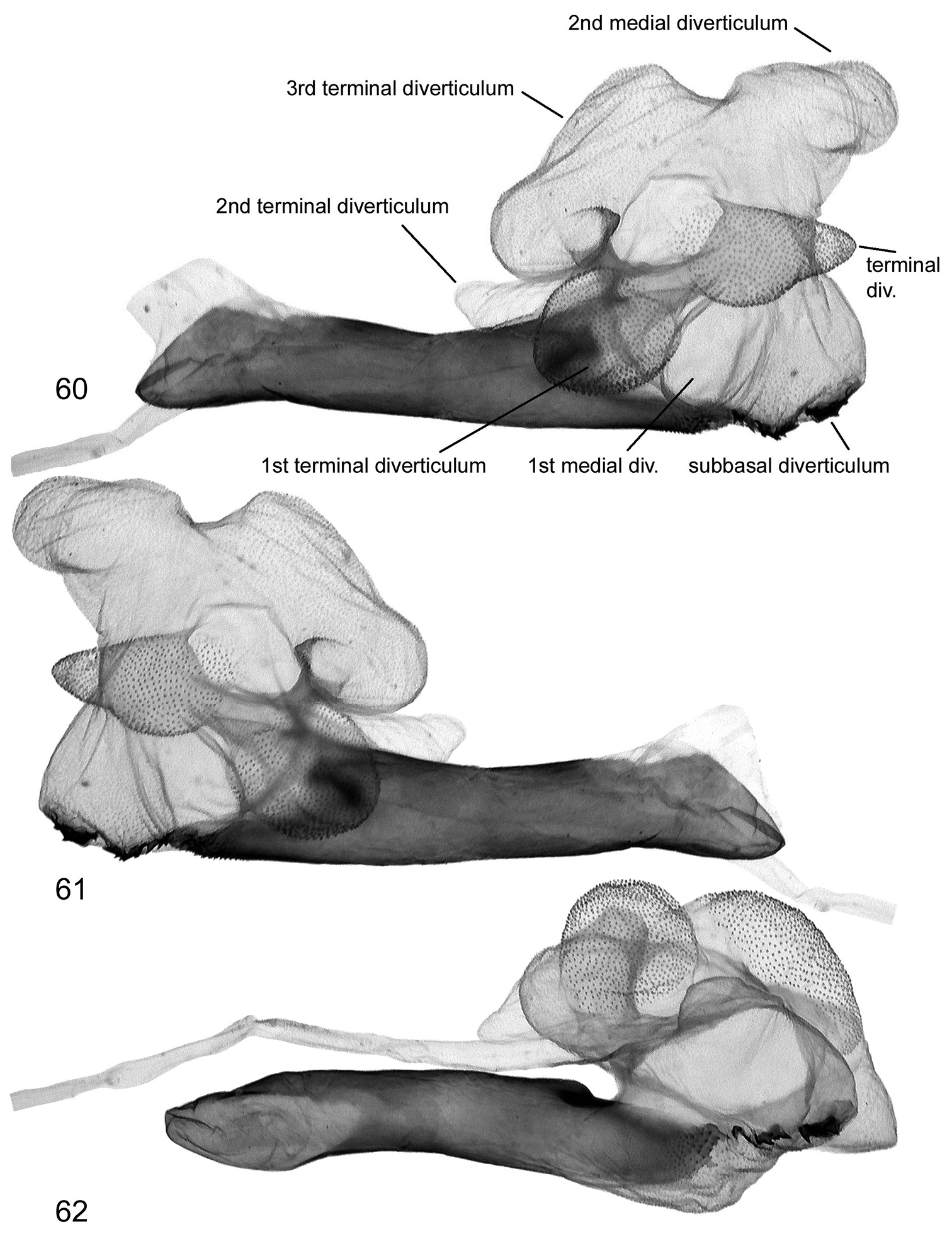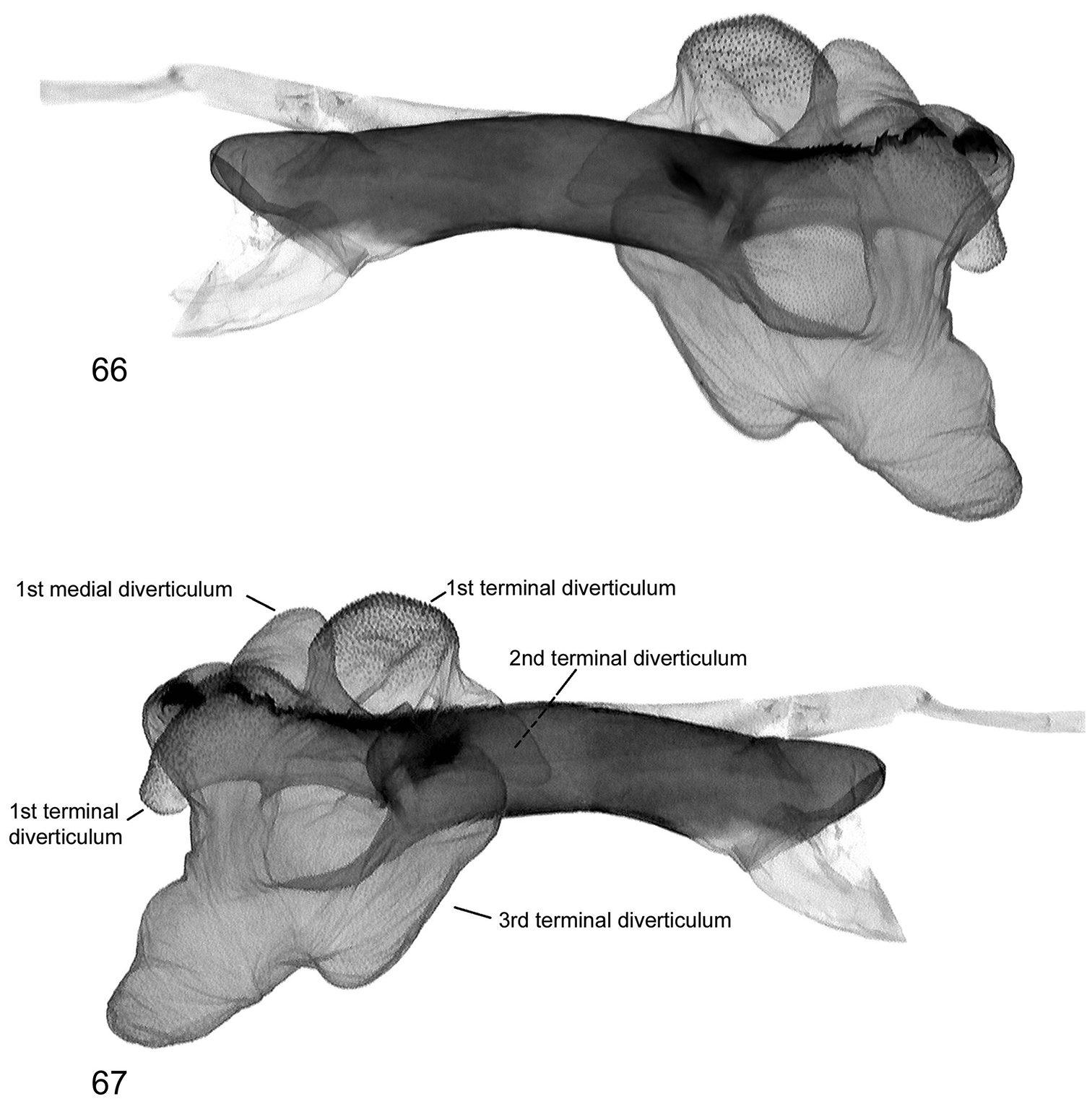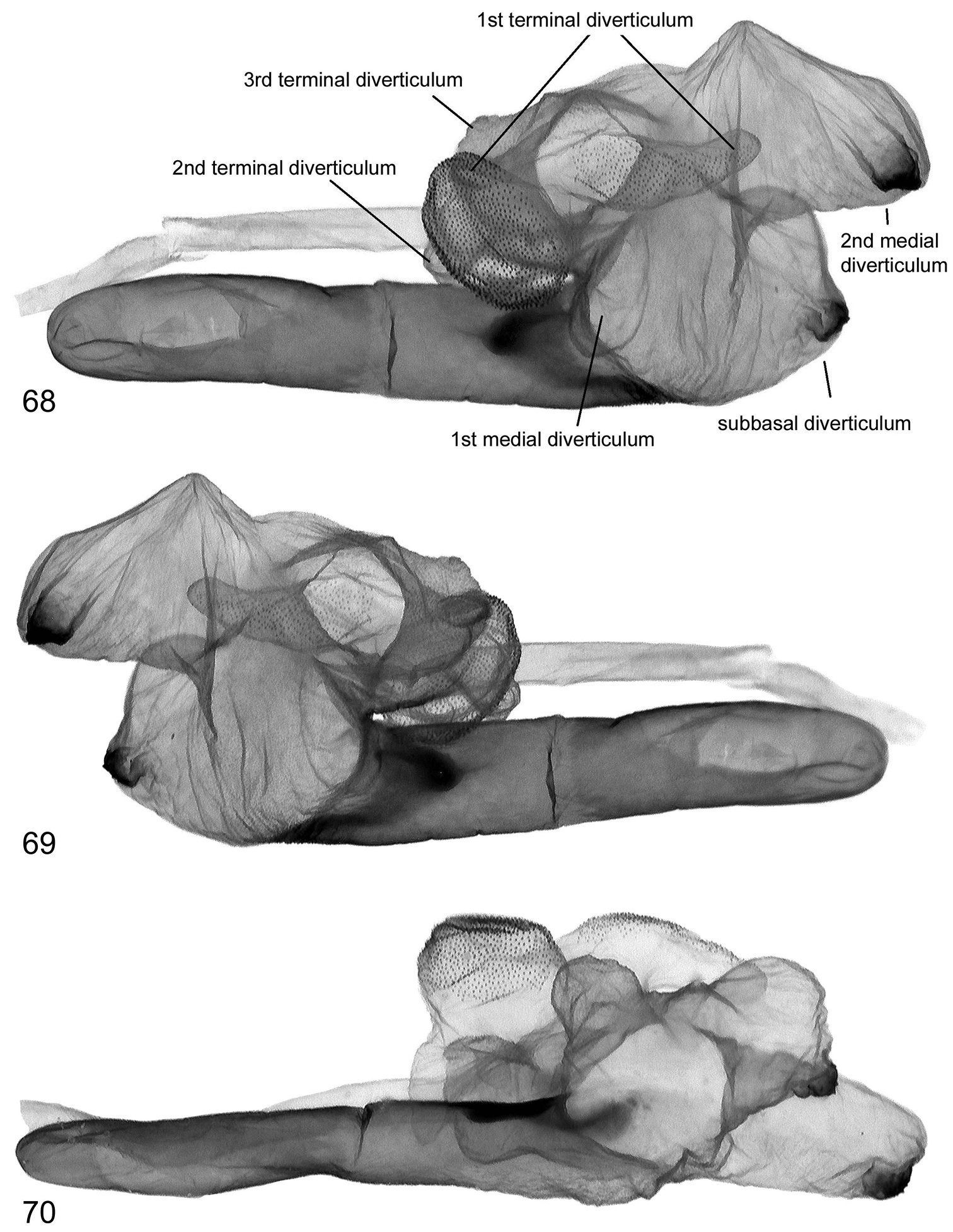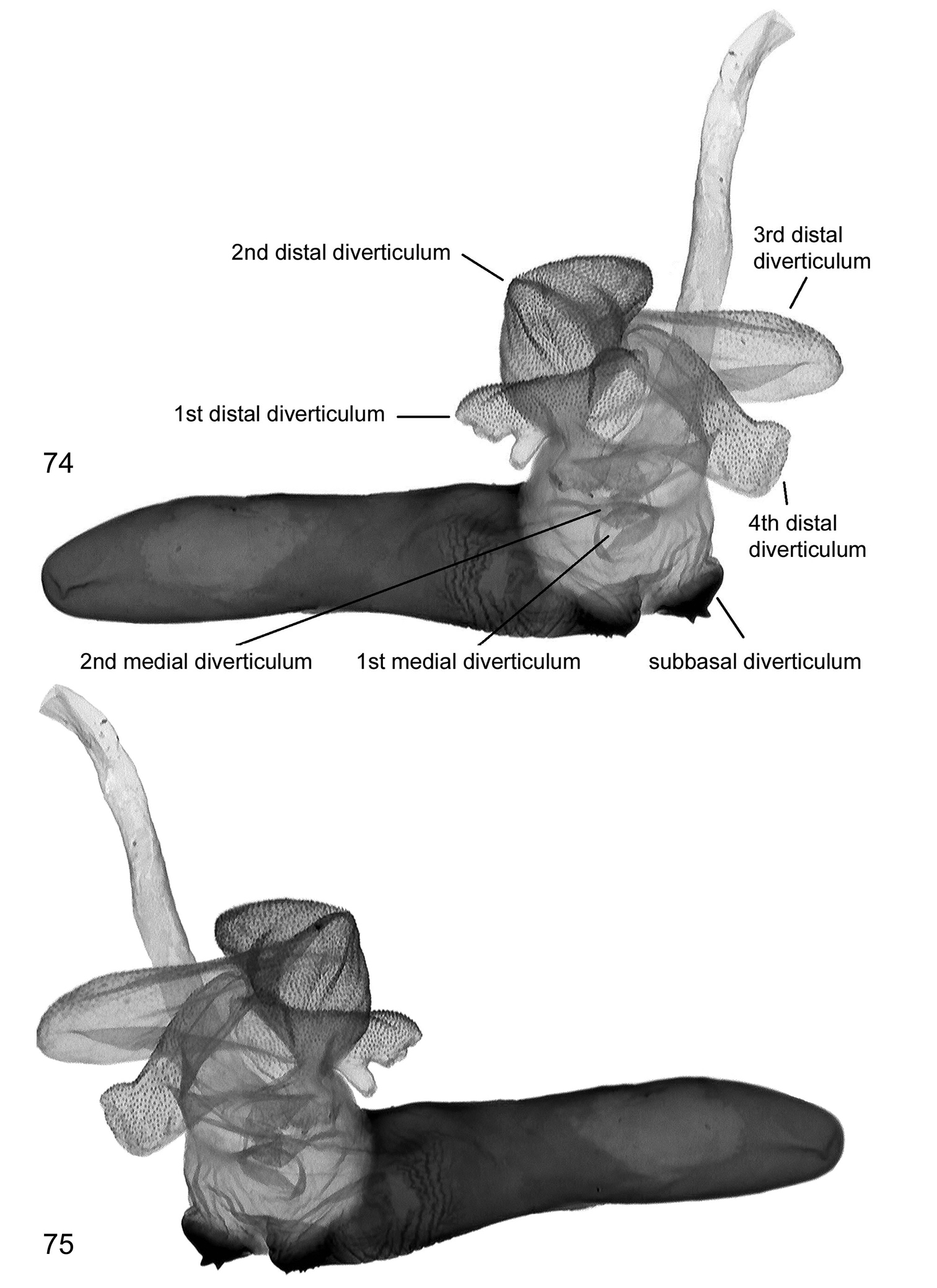






(C) 2013 Oleg Pekarsky. This is an open access article distributed under the terms of the Creative Commons Attribution License 3.0 (CC-BY), which permits unrestricted use, distribution, and reproduction in any medium, provided the original author and source are credited.
For reference, use of the paginated PDF or printed version of this article is recommended.
Citation: Pekarsky O (2013) Taxonomic and morphological survey of the Lygephila lusoria (Linnaeus, 1758) species-group with description of a new species (Lepidoptera, Erebidae, Toxocampinae). ZooKeys 351: 49–81. doi: 10.3897/zookeys.351.5999
The taxa of the Lygephila lusoria (Linnaeus, 1758) species-group are revised. The genital features of all known taxa are described and illustrated with special reference to the structure of vesica. The male genitalia of L. pallida pallida (Bang-Haas, 1907) are described and illustrated for the first time. L. pallida subpicata (Wiltshire, 1971) is treated here as a species, L. pallida subpicata (Wiltshire, 1971), stat. n., distinct from L. pallida. A new species, L. minima, sp. n., from South Russia is described. Illustrations of the holotype and its genitalia are provided; a diagnostic comparison with L. pallida is given. L. alaica Remm, 1983 is included in the L. lusoria species-group for the first time.
Lepidoptera, Erebidae, Toxocampinae, Lygephila lusoria species-group, new species, vesica structure, Russia, Europe
The genus Lygephila Billberg, 1820 is a popular group; several authors have published new results concerning the taxonomy, faunistics and bionomics of the group during the last century, increasing our knowledge of this diverse and taxonomically difficult group. The recent wave of investigations, after the works of
Abbreviations of material depositories BMNH = The Natural History Museum (British Museum, Natural History) London (United Kingdom), HNHM = Hungarian Natural History Museum Budapest (Hungary); MA = Matov Alexey, St. Petersburg (Russia); MNHN = Museum National d’Histoire Naturelle Paris (France); MNHU = Museum für Naturkunde der Humboldt-Universität zu Berlin (Germany); NHMW = Naturhistorisches Museum Wien (Vienna, Austria); ZISP = Zoological Institute, Russian Academy of Sciences St. Petersburg (Russia); OP = Oleg Pekarsky, Budapest (Hungary).
Male and female genitalia were dissected and mounted in euparal on glass sides. Photos of genitalia where made by Svitlana Pekarska using microscope Nikon SMZ745T and camera Moticam 2500. Photos of imago where taken by the author using camera Nikon D3000/Sigma 105, f/2.8.
Head and body greyish brown with frons and collar chocolate brown. Forewing in general broad, elongated with pointed apex, greyish brown with indistinct transverse lines, orbicular stigma dot-like, reniform stigma more or less triangular, black, sometimes with sharp extension at inner corner and satellite streak-like spots on outer margin; hindwing with wide outer band and visible discal spot. The first characterisation of the genitalia structure of the Lygephila lusoria species-group was given by Babics and Ronkay in
The Lygephila lusoria species-group comprises the following species: Lygephila lusoria lusoria (Linnaeus, 1758); Lygephila lusoria glycyrrhizae (Rambur, 1866); Lygephila amasina (Staudinger, 1878); Lygephila colorata Babics & Ronkay, 2009; Lygephila moellendorffi (Herz, 1904); Lygephila pallida (Bang-Haas, 1907); Lygephila subpicata Wiltshire, 1971, stat. n.; Lygephila minima sp. n.; Lygephila fereidun Wiltshire, 1961; Lygephila alaica Remm, 1983.
http://species-id.net/wiki/Lygephila_lusoria_lusoria
Figs 1–41 ♂, Hungary, Pilisszántó, Üdülőtelep, Plachkó u., 18.VI.2007, leg. & coll. O. Pekarsky slide No: OP1953m, 1 ♀, Hungary, Naszály, Sejce, N47°50'304, E019°06'762, 11.VI.2007 leg. & coll. O. Pekarsky, slide No: OP1954f; 1 ♂, 1 ♀, Süd-Frankreich, Provence Serres, 4 km südlich Orpierre, 1000 m, 18.07.1999, leg. P. Kuhna, coll. ZFMK, slide Nos: OP2263m, OP2264f; 1 ♂, 1 ♀, Crimea, Alushta, Luchistoe, South Demergi Mt., 16.06.2012, leg. V. Savchuk, coll. N. Kaygorodova, slide Nos: OP2052m, OP2053f; 1 ♂, Russia, S Ural, Orenburg Obl., Kuvandyk, 23–24.6.2009, leg. & coll. L. Srnka, slide No: OP2122m.
Lygephila lusoria lusoria is the largest representative of the species group. Differ from Lygephila amasina by less contrast wing pattern and not sharp inner corner of the reniform stigmata. Nominotypical subspecies in most cases lager, with more contrast wing pattern comparing with Lygephila lusoria glycyrrhizae from Spain.
Male genitalia (Figs 25, 39, 40). Uncus stem narrow and relatively long, dilated distally with fine tip, scaphium membranous with sclerotized plate on subscaphium; valva elongated, narrowed at base, apex rather acute; ampulla spine-like, almost straight, not reaching apex of valva, its base asymmetrical. Aedeagus straight, tubular, slightly dilated at carina with heavily sclerotized field on it. Vesica globular, everted forward and recurved laterally; medial part membranous; subbasal diverticulum oblate with heavily sclerotized crest contacting carina; 1st medial diverticulum small; 2nd and 3rd medial diverticula elongated, tube-like, rising from extension of main vesica chamber located opposite to each other; 4th medial diverticulum on opposite side topped with large, rounded, plate-like cornutus with two teeth; 1st terminal diverticulum tapered with large basal swelling; 2nd terminal diverticulum tapered, bordering 2nd medial diverticula, bearing three small pockets; terminal tube membranous with weak scobination at end near gonopore (starting point of ductus ejaculatorius), opening point of terminal tube located at base of medial part of vesica near carina. Female genitalia (Figs 76, 77). Ovipositor relatively short, broad; papillae anales hairy with long setae on apical edges. Apophyses anteriores slender, apophyses posteriores thin with acute tips, longer than apophyses anteriores. Antrum tapering, ostium bursae broad with acute lateral edges, posterior margin incised producing shallow triangular cleft with almost straight margins; ductus bursae large, wide with coarse well-sclerotized wrinkles laterally. Appendix bursae small with ductus seminalis located near ductus bursae. Corpus bursae membranous, large, ellipsoidal.
West Palearctic. In Europe it ranges from Spain to Bulgaria, from Ukraine to south Russia and western Kazakhstan (Uralsk). All earlier records for Asia Minor refer to Lygephila amasina, whereas the records from north Caucasus and Transcaucasia belong to Lygephila minima sp. n.
Adults. 1–4 Lygephila lusoria lusoria 1 male, Hungary, slide No. OP1953m 2 female, Hungary, slide No. OP1954f 3 male, S Ural, slide No. OP2122m 4 female, France, slide No. OP2264f 5–7 Lygephila lusoria glycyrrhizae 5 male, Spain, Andalusia, slide No. OP1977m 6 female, Spain, Andalusia, slide No. OP1978f 7 female, Spain, Granada, slide No. OP2265f 8 Lygephila moellendorffi paratype, male, N Korea (photo A. Matov).
http://species-id.net/wiki/Lygephila_lusoria_glycyrrhizae
Figs 5–71 ♂, Andalusien, Sierra de Alfacar, 1905, C. Ribbe, coll. MNHU Berlin, slide No: OP1977m; 1 ♀, Andalusien, Sierra de Alfacar, 1905, C. Ribbe, coll. MNHU Berlin, slide No.: OP1978f; 1 ♀, Espania, S. Albarracin, 1500m, (Teruel), 8.7.1987, leg. Fidel Fernandez-Rubio, coll. P. Gyulai, slide No.: OP2128f; 1 ♀, Spain, Sierra de Bata, Sta Barbara, Granada, 1800 m, 30.vi.1994, leg. B. Goater, coll. G. Ronkay, slide No.: OP2137f; 1 ♀, Spanien, Granada, Sierra Nevada, Pico Valeta, 2500 m, 4.7.1987, leg. P. Kuhna, coll. ZFMK, slide No.: OP2137f.
The name of this taxon is unavailable from Rambur, 1866, and there is some debate as to the correct authorship and date of this subspecies. This issue will be dealt with in a separate publication.
This taxon was downgraded to a subspecies of Lygephila lusoria by
Male genitalia (Figs 26, 41, 42). Uncus stem narrow and relatively short, dilated distally with fine tip; scaphium membranous with sclerotized plate on subscaphium; valva elongated, narrowed at base, margins not parallel due to large costal dilatation medially, valval apex rather acute; ampulla almost straight, spine-like with symmetrical base. Aedeagus a straight tube with heavily sclerotized field on carina. Vesica globular, everted forward and recurved laterally; medial part membranous; subbasal diverticulum oblate with heavily sclerotized crest contacting carina; 1st medial diverticulum small; 2nd and 3rd medial diverticula elongated, tube-like, rising from extension of main vesica chamber, located opposite to each other; 4th medial diverticulum on opposite side topped with large, rounded, plate-like cornutus with two teeth; 1st terminal diverticulum tapered, with large basal swelling; 2nd terminal diverticulum bears three small pockets; terminal tube membranous with weak scobination at distal end near gonopore (starting point of ductus ejaculatorius); opening point of terminal tube located at base of medial part of vesica near to carina. Female genitalia (Figs 78–80). Ovipositor relatively short, broad, papillae anales hairy with long setae on apical edges. Apophyses anteriores slender, apophyses posteriores longer than apophyses anteriores, thin with acute tips. Antrum tapering, ostium bursae broad with acute lateral edges, posterior margin incised showing shallow triangular cleft with almost straight margins; ductus bursae large, wide with coarse well-sclerotized wrinkles laterally. Appendix bursae small with ductus seminalis located near ductus bursae. Corpus bursae membranous, large, elongated, ellipsoidal.
Spain.
1 ♂, Turkey, Prov. Agri, Karasu-Aras Mts, 2100m, 7km E from Aydintepe, 42°28'27"E, 39°47'4"N, 04.VII.2000, leg. Gy. Fábián, I. Szécsényi & K. Székely, coll. O. Pekarsky, slide No.: OP1959m; 1 ♂, Türkei, 12 km west Ürgüp, 1400 m, 21.6.1979, leg. P. Kuhna, coll. ZFMK, slide No. OP2260m; 1 ♀, Türkei, 12 km west Ürgüp, 1400 m, 11.9.1981, leg. P. Kuhna, coll. ZFMK, slide No. OP2261f; 1 ♀, Libanon, Jabal el Laqlouq, Street Mkhada–Laqloq, 1300–1500 m NN, 13.06.1999, leg. J. Krüger, coll. ZFMK, slide No. OP2262f; 1 ♀, Lebanon, Laqlouq, h-1600m, 25.07.2011, leg. Floriani & Saldaitis, coll. O. Pekarsky, slide No.: OP1960f.
Lygephila amasina distinguishing from similar Lygephila lusoria lusoria by more contrast wing pattern and somewhat longer, sometimes with acute apex of inner corner of the reniform stigmata. In genital structures it differs from Lygephila lusoria by broader uncus, longer, thinner ampulla reaching apex of valva, not sharp lateral edges of antrum and ovoid corpus bursa.
Male genitalia (Figs 27, 43–46). Slightly asymmetrical (right valva narrower). Uncus short, dilated distally, with fine tip; scaphium membranous with sclerotized plate on subscaphium; valva elongated, narrowed at base with apex rather acute; ampulla long, stick-like, slightly curved towards costa, reaching apex of valva. Aedeagus short with heavily sclerotized convex field on carina and spinulose area on lamina. Vesica small, globular, everted laterally; medial part membranous; heavily sclerotized crest with ridge-like cornutus complex based on elongated oblate diverticulum-like subbasal hump; 1st medial diverticulum medium-sized, 2nd medial diverticulum much larger, located on the opposite side of vesica with sclerotized area on the top; 1st terminal diverticulum two-chambered, one of them elongated tapering, another globular; 2nd terminal diverticulum tapering with acute top; 3rd terminal diverticulum situated in the same line with 2nd medial diverticulum; opening point of terminal tube located at base of medial part of vesica near to carina; terminal tube membranous with narrow sclerotized crest at base and weak scobination at distal end near gonopore (starting point of ductus ejaculatorius). Female genitalia (Fig. 81). Ovipositor short, papillae anales hairy with long setae on apical edges. Apophyses anteriores slender, apophyses posteriores thin, 1.6 times longer than apophyses anteriores. Antrum infundibuliform, asymmetrical, with heavily sclerotized elongated plate dorsally; ostium bursae broad, posterior margin gently concave; ductus bursae practically absent. Appendix bursae indistinct. Corpus bursae membranous, ovoid.
Turkey, Lebanon and Israel.
Adults. 9, 10 Lygephila amasina 9 male, Turkey, slide No. OP1959m 10 female, Lebanon, slide No. OP1960f 11, 12 Lygephila colorata 11 paratype, male, Pakistan, slide No. OP1969m 12 paratype, female, Pakistan, slide No. OP1970f 13, 14 Lygephila alaica 13 male, Tajikistan, slide No. OP1819m 14 female, Uzbekistan, slide No. OP1792f 15, 16 Lygephila subpicata 15 male, Iran, Zagros Mts, slide No. OP2002m 16 paratype, female, Iran, Semnan slide No. OP2060f.
1 ♂, Paratype, Pakistan, Karakoram Mts, Naltar valley, 2800m, 74°12'E, 36°09.6'N, 30.06.2000, leg. Z. Varga & G. Ronkay, coll. O. Pekarsky, slide No.: OP1969m; 1 ♀, same data as male, slide No.: OP1970f.
Lygephila colorata differ from somewhat externally similar Lygephila amasina by more elongated forewing with pointed apex. In male genitalia it differ from congeners by very wide, massive valva, strong, thick ampulla. Female genitalia characterised by deeply concave posterior margin of antrum.
Male genitalia (Figs 30, 47–51). Clasping apparatus slightly asymmetrical (right valva narrower). Uncus short, dilated medially, apex with fine tip; scaphium membranous with sclerotized plate on subscaphium; valva elongated, narrowed at base with rather rounded apex (right valva more acute); ampulla large, massive, slightly curved towards costa, with obtuse tip. Aedeagus short, bent medially, with heavily sclerotized convex field on carina and spinulose area on lamina. Vesica large rather globular, multidiverticulate, everted laterally; medial part membranous; 1st subbasal diverticulum bearing heavily sclerotized crest with ridge-like cornutus complex; 2nd subbasal diverticulum bifurcated, composed from two narrow, elongated tube-like diverticula; medial diverticulum large, elongated, S-shaped with bilobate base and tapering upper part with acute tip; large, elongated terminal complex consists of five diverticula, one of them with densely scobinated top; opening point of terminal tube located at base of vesica near the carina; terminal tube membranous with slightly sclerotized area at base and weak scobination near gonopore (starting point of ductus ejaculatorius). Female genitalia (Fig. 82). Ovipositor short, papillae anales small, hairy with long setae on apical edges. Apophyses anteriores slender with fine tip, apophyses posteriores thin, somewhat longer than apophyses anteriores. Antrum U-shaped, asymmetrical, ostium bursae broad, posterior margin deeply concave; ductus bursae small. Appendix bursae small. Corpus bursae membranous, ovoid.
North-western Pakistan.
1 ♂, Cotype label1: Cotype, pallida B.-H. ♂; label2: As. min. m. (Zeitun), revers - pallida B.-H. ♂, 5/08 vom Autor; label3: Zeitun; label4: 962; ex. coll. Püngeler, coll. MNHU Berlin, slide No: OP1933m; 1 ♂, Turkey, Prov. Kayseri, 5 km NW Ercios Dagh, 2000 m, 22.7.1986, leg. M. Fibiger, coll. G. Ronkay, slide No: OP1967m; 1 ♂, Turkey, Prov. Sivas, Ziyaret gecidi, 2100 m, 36°45'E, 38°42'N, 27–28.07.1993, leg. Gy. László, coll. O. Pekarsky, slide No: OP1961m; 1 ♀, Turkey, Prov. Sivas, Ziyaret gecidi, 1950–2050 m, 36°45'E, 38°42'N, 27.07.1988, leg. Gyulai, Hreblay, Ronkay & Ronkay, coll. G. Ronkay, slide No: OP1966f; 1 ♀, Türkey, Prov. Sivas, 5 km E of Imranli, 38°06'E, 39°53'N, 11.VII.1989, leg. & coll. P. Gyulai, slide No: OP2014f; 1 ♂, [Turkey] O Anatolien, Gürün, 4.VII.76, leg. Pinker, coll. NHMW, Vienna, slide No: OP2065m; 1 ♀, [Turkey] O Anatolien, Gürün, 4.VII.76, leg. Pinker, coll. NHMW, Vienna, slide No: OP2066f; 1 ♂, Turkey, Prov. Erzurum-Erzincan, 10 km W of Askale, 1700m, 40°34'E, 39°50'N, 08.08.1988, leg. Gyulai, Hreblay, Ronkay & Ronkay, coll. G. Ronkay, slide No: OP2029m; 1 ♂, Turkey, Prov. Erzurum, 4 km W of Tahir, 2500 m, 42°27'E, 39°51'5"N, 22.07.1993, leg. Gy. László, coll. G. Ronkay, slide No: OP2030m; 1 ♂, Türkei, Palandoeken, 2500 m, 28 Juli 1980, leg. Dittrich Austria, coll. NHMW, Vienna, slide No: OP2069m; 1 ♀, Türkei, Palandoeken, 2500 m, 28 Juli 1980, leg. Dittrich Austria, coll. NHMW, slide No.: OP2070f; 1 ♀, Turkey, Prov. Agri, 7 km W of Aydintepe, 2200 m, 42°30'E, 39°49'N, 20–22.VII.1990, leg. Gy. László & G. Ronkay, coll. G. Ronkay, slide No: OP1968f.
Distinguishable from similar species only by genitalia characters. It differ from Lygephila subpicata by shorter spine-like ampulla not reaching the valval edges and from Lygephila minima sp. n. by narrower valva, longer ampulla and absents of sclerotization on top of the 2nd medial diverticulum.
Male genitalia (Figs 31, 52–59). Clasping apparatus somewhat asymmetrical (right valva narrower). Uncus stem narrow, short, dilated distally, with fine tip; scaphium membranous with weakly sclerotized plate on subscaphium; valva elongated, narrowed at base with rather acute apex; ampulla spine-like, slightly curved towards costa, finely pointed, does not reaching apex of valva. Aedeagus short, slightly curved medially, with heavily sclerotized convex field on carina and spinulose area on lamina. Vesica globular, everted forward and recurved laterally; medial part membranous; heavily sclerotized ridge on subbasal diverticulum with cornutus complex contacting carina at base; 1st medial diverticulum medium-sized, wide at base; 2nd medial diverticulum very large, conical, with sclerotized area on the top; 1st terminal diverticulum two chambered, one of them elongated tapering, another globular; 2nd terminal diverticulum tapered; 3rd terminal diverticulum elongated with very wide base and curved tapered part; opening point of terminal tube located at base of medial part of vesica near carina, terminal tube membranous with narrow sclerotized crest at base and weak scobination near gonopore (starting point of ductus ejaculatorius). Female genitalia (Fig. 83). There were no females with type labels or from the same collecting place as the cotype in the MNHU collection. Taking into consideration that the exemplar from Palandöken, Turkey is the most similar in male genitalia structure to the cotype specimen (the two slides are almost fully agree with each other) one can conclude that the female specimen from the same site would represent the female sex of Lygephila pallida. Ovipositor short, papillae anales small, hairy with long setae on apical edges. Apophyses anteriores slender with fine tip, apophyses posteriores thin, somewhat longer than apophyses anteriores. Antrum U-shaped, asymmetrical, ostium bursae broad, posterior margin deeply concave with large prolongation of posterior end on one side; ductus bursae small, practically absent. Appendix bursae small. Corpus bursae membranous, ovoid.
Central and eastern Turkey.
Adults. 17, 19, 20 Lygephila pallida 17 Cotype, male, Turkey, Zeitun, slide No. OP1933m 18 Lygephila fereidun holotype, male, Iran, Elburz (photo G. Ronkay) 19 male, Turkey, Prov. Sivas, slide No. OP1961m 20 female, Turkey, Prov. Sivas, slide No. OP2014f 21–24 Lygephila minima sp. n. 21 holotype, South Russia, Stavropol krai, slide No. 0329Matov (photo A. Matov) 22 paratype, male, South Russia, Stavropol krai, slide No. OP1607m 23, 24 paratypes, males, South Russia, Stavropol krai (photo A. Matov).
Clasping apparatus 25 Lygephila lusoria lusoria Hungary, slide No. OP1953m 26 Lygephila lusoria glycyrrhizae Spain, slide No. OP1977m 27 Lygephila amasina Turkey, slide No. OP1959m 28 Lygephila fereudun Type, Iran, Elburz, after
Clasping apparatus 31 Lygephila pallida Cotype, Turkey, Zeitun, slide No. OP1933m 32 Lygephila subpicata Iran, Prov. Fars, slide No. OP2002m 33, 34 Lygephila moellendorffi paralectrotype, N Korea, slide No. VK210394-10 ZIN (photo V. Kononenko) 35, 37 Lygephila minima sp. n. holotype, South Russia, Stavropol krai, slide No. 0329Matov (photo A. Matov) 36, 38 paratype, male, South Russia, Stavropol krai, slide No. OP1607m.
This taxon, described from the Elburz Mountains, Northern Iran, is known only from the holotype (coll. BMNH). In the original description the color was characterized as pale straw and the wing pattern close to the Spanish species glycyrrhizae. The diagnostic comparison was made with Lygephila craccae ([Denis & Schiffermüller], 1775) and Lygephila lusoria only, whereas a comparison with another similar species, Lygephila pallida, was neglected. The original description contains the following text about the clasping apparatus structure (Fig. 28): “The harpe [ampulla], longer than that of craccae, is nevertheless shorter than that of lusoria.” Comparative analysis of the ampullar length (shorter than that of lusoria) given by Wiltshire, makes it possible to conclude that the Lygephila fereidun is different from the Lygephila amasina and Lygephila subpicata, because they have longer ampullae that reach the costal margin of the valva. So, by this feature Lygephila fereidun could be compared only with Lygephila pallida, the ampulla of which is rather shorter than that of Lygephila lusoria and other members of its species group. Vesica structure in the original description is characterized as follows: “The vesica contains similar elements to those of lusoria but the proximal scobinated field is shorter and the five or six teeth on the distal chitinous lump are larger and more like cornuti than in lusoria.” However, the only sclerotized cornutus formation illustrated in the original drawing looks similar to that of Lygephila subpicata, but Lygephila subpicata has two heavily-sclerotized crown-like cornuti on the top of subbasal and 2nd medial diverticula.
The above-mentioned contradictions in the original description thereby make it impossible to clarify the taxonomical situation of this taxon without a study of the genitalia of the holotype, the preparation of which is opaque and requires specific recovery treatment. Based on the currently known characters Lygephila fereidun is most likely an aberrant specimenof Lygephila pallida.
Northern Iran.
http://zoobank.org/ED5224B3-3A40-4A84-8EFA-F4F498213211
http://species-id.net/wiki/Lygephila_minima
Figs 21–24Holotype: Male (Fig. 21), [Russia], Stavropolskiy krai, NW suburbs of station Podkumok, 26.06.2008, leg. E. Tsvetkov, slide No.: 0329Matov (coll. ZISP)
Paratypes. Males. 1 ♂, [Russia], Stavropolskiy krai, suburbs of Pyatigorsk, station Podkumok, 20.07.2007, leg. E. Tsvetkov; slide No.: OP1607m (coll. O. Pekarsky). 2 ♂♂, [Russia], Stavropolskiy krai, suburbs of station Podkumok, 43°57'43''N, 42°46'18''E, leg. E. Tsvetkov, 20.07.2007; 1 ♂, [Russia], Stavropolskiy krai, suburbs of Piatigorsk, station Podkumok, 18.07.2007, leg. E. Tsvetkov; 1 ♂, Armenia, Daralagez, 12.VIII.[19]63, slide No.: 0341Matov (coll. ZISP).
The name “minima” refers to the small size of the moth in contrast to the largest representative of the genus, Lygephila maxima (Bremer, 1861).
The new speciesresembles Lygephila pallida by its small size and pale brown ground color of the forewing. Lygephila minima differs from the related species by its better developed noctuid pattern, more rounded wings and pale grey-brown ground color of the forewings. Apical dilatation of uncus wide, valva wide with rounded apex, ampullar tip not sharp, 1st medial diverticulum reniform; 2nd medial diverticulum hemispherical, membranous, without sclerotized areas, whereas Lygephila pallida has narrower dilatation at the top of the uncus, longer, narrower valva with acute apex, fine tipped ampulla, 1st medial diverticulum very wide at base, swelling-like; 2nd medial diverticulum large, tubular, with sclerotized area on the top.
Male (Figs 21–24). Wingspan 33 mm, length of forewing 17 mm. Head and collar coffee brown. Palpi short, relatively narrow, beige; antenna filiform. Thorax and abdomen beige. Forewing beige with silver shining, irrorated with a few blackish-brown scales; forewing short, wide; costa straight; outer margin rounded; wing pattern indistinct: basal, subbasal and antemedial lines hardly recognisable; medial line represented by large costal patch and some darker spots medially; postmedial line indistinct; subterminal line curved, composed by blackish-brown scales; terminal line marked by large triangular patches; cilia long, uniformly light brown; orbicular stigma dot-like, as coffee-brown colored as V-shaped reniform; claviform stigma indistinct. Hindwing beige brown, discal spot narrow. Female unknown.
Male genitalia (Figs 35–38, 60–67). Uncus stem short, broadly dilated distally with fine tip; valva short, wide, rounded apically with rather parallel margins in distal two-thirds, slightly narrower at base; ampulla spine-like with long base and pointed tip which does not reaching margin of valva. Aedeagus short, curved medially, with heavily sclerotized field on carina and spinulose area on lamina. Vesica globular, everted forward and recurved laterally; medial part membranous; basal cornutus ridge interrupted without sclerotized base, subbasal diverticulum medium sized; 1st medial diverticulum large, reniform; 2nd medial diverticulum hemispherical; 3rd medial diverticulum tapered, 1st distal diverticulum large, subconical, 2nd distal diverticulum with wide base and crooked tip; opening point of terminal tube located at base of medial part of vesica, terminal tube membranous with sclerotized ribbon at base and weak scobination at end near gonopore.
The species is known from south Russia, Stavropol region and Armenia.
1 ♂, 1 ♀ Paratypes, N-Iran, Berge östl. Semnan, 18.VI.1963, leg. Kasy & Vartian, coll. NHMW, slide Nos: OP2059m, OP2060f; 1 ♂, 1 ♀ S-Iran, 100 km südl. Abadeh, nördl Didegan, 2000 m, 9.6.1969, leg. Vartian, coll. NHMW, slide Nos: OP2061m, OP2062f; 2 ♂♂ Iran, Prov. Fars, Zagros Mts, Ardakan, 2500–3000 m, 18.VI.2010, leg. B. Benedek & T. Hácz, coll. P. Gyulai, slide Nos: OP2002m, OP2003m.
Lygephila subpicata differs from its sister species, Lygephila pallida in the length and shape of the ampulla, and in vesica and aedeagus structure. Lygephila subpicata has a much longer, curved ampulla, which reaches apex of valva and costal margin; subbasal diverticulum large with crown-like cornutus on top, tapering part of 1st terminal diverticulum small, short and narrow, 2nd medial diverticulum with crown-like cornutus on top, carinal extension practically absent. In comparison, Lygephila pallida has shorter, less curved, finely pointed ampulla that does not reach apex of valva, a small, oblate subbasal diverticulum with a long, heavily-sclerotized, ridge-like cornutus complex that is a continuation of the carina.
Male genitalia (Figs 32, 68–73). Clasping apparatus somewhat asymmetrical. Uncus stem narrow, short, dilated distally, with fine tip; scaphium membranous with weakly-sclerotized plate on subscaphium; valva elongated, narrowed at base, with acute apex; ampulla long, spine-like, curved towards costa, finely pointed, reaching apex of valva and costal margin. Aedeagus short, straight, with heavily sclerotized convex field on carina. Vesica globular, everted forward and recurved laterally; medial part membranous; subbasal diverticulum with small, heavily-sclerotized crown-like cornutus on top; 1st medial diverticulum elliptical; 2nd medial diverticulum large with crown-like cornutus on the top; 1st terminal diverticulum two-chambered, scobinated, one of them elongated-tapering, another globular; 2nd terminal diverticulum tapered; opening point of terminal tube located at base of medial part of vesica near carina, terminal tube membranous with narrow sclerotized crest at base and weak scobination near gonopore (starting point of ductus ejaculatorius). Female genitalia (Fig. 84). Ovipositor short, papillae anales small, hairy with long setae on apical edges. Apophyses anteriores slender with fine tip, apophyses posteriores thin, somewhat longer than apophyses anteriores. Antrum triangular, very narrow anteriorly, wide posteriorly, with straight lateral margins, ductus bursae absent. Corpus bursae membranous, ovoid.
North and western Iran.
Paralectotype, ♂ [North] Korea (ZISP).
The name of this taxon was erroneously written as moellendorfii in
Lygephila moellendorffi is known only from two males representing the type series. The photo of the paralectotype was illustrated in
Male genitalia (Figs 33, 34). Clasping apparatus somewhat asymmetrical (left valva slightly wider). Uncus stem narrow, dilated distally, with fine tip; valva elongated, narrowed at base, with acute apex; ampulla long, spine-like, curved towards costa, finely pointed, reaching apex of valva and costal margin. Aedeagus short, straight, with heavily sclerotized convex field on carina. Vesica globular, everted forward and recurved laterally; medial part membranous; subbasal diverticulum with small, crown-like cornutus on top; 1st medial diverticulum elliptical; 2nd medial diverticulum large with crown-like cornutus on the top; 1st terminal diverticulum located near base of 2nd medial diverticulum. Female unknown.
North Korea.
1 ♂ Tajikistan, Gissar Mts, distr. Varzob, vill. Kondara, 1150–1200 m, 17–18.VI.2012, leg. E. Rutjan, coll. O. Pekarsky, slide No: OP1819m; 1 ♀, Tajikistan, Khatlonskaya reg., Muminabadsky distr., Lidzhak, 2000 m, 27.V.2006, leg. O. Pak, coll. O. Pekarsky, slide No: OP1568f; 1 ♀, Uzbekistan, Hissarskiy range, Metchetli Mts, Shargunsay, 38°36'N, 67°57'E, 1550m, 30.May, 2004, leg. Z. Weidenhoffer, coll. M. Dvořák, slide No: OP1792f.
Lygephila alaica should be attributed to the Lygephila lusoria species-group on the basis of both the external and genital diagnostic characters. The elongated forewing with pointed apex is similar to those of all species of this species-group, particularly to eastern representatives, Lygephila colorata and Lygephila subpicata. The spine-like ampulla with long skewed base, the short and wide aedeagus, the characteristic vesica structure, especially the presence of the well-developed subbasal diverticulum with large cornutus in the male genitalia and the heavily sclerotized, funnel-shaped antrum with strongly asymmetrical ostium bursae in the female genitalia indicate the close relationship with the Lygephila lusoria species-group.
Male genitalia (Figs 29, 74, 75). Slightly asymmetrical (right valva somewhat narrower). Uncus stem narrow, moderately dilated distally, with fine tip; scaphium membranous with sclerotized plate on subscaphium; valva wide, elongated with almost parallel margins, apex rounded; ampulla dentiform with large plate-like lateral extension. Aedeagus straight, carina slightly dilated with transverse wrinkles. Vesica globular, everted laterally; medial part membranous; small subbasal diverticulum topped by heavily sclerotized plate-like cornutus with two teeth; 1st and 2nd medial diverticula small; 1st distal diverticulum resembles high-heeled shoe, 2nd, 3rd and 4th distal diverticula roughly equal in size and similar in shape; opening point of terminal tube located at base of medial part of vesica near carina, membranous with weak scobination from middle towards gonopore. Female genitalia (Fig. 85). Ovipositor relatively short, broad, papillae anales hairy with short setae on apical edges. Apophyses anteriores slender, apophyses posteriores thin, more than two times longer than apophyses anteriores. Antrum wide, short, ostium bursae asymmetrical, posterior margin with skewed concavity; ductus bursae as large as antrum, heavily sclerotized. Appendix bursae small, corpus bursae membranous, ovoid.
Central Asia – Tajikistan and Uzbekistan.
Vesica structure of Lygephila lusoria lusoria Hungary, slide No. OP1953m 39 dorsal view 40 ventral view.
Vesica structure of Lygephila lusoria glycyrrhizae Spain, slide No. OP1977m 41 dorsal view 42 ventral view.
Vesica structure of Lygephila amasina Turkey, slide No. OP2260m 43 dorsal view 44 ventral view 45 lateral view 46 lateral view opposite side.
Vesica structure of Lygephila colorata paratype, Pakistan, slide No. OP1969m 47 dorsal view 48 ventral view 49 sublateral view.
Vesica structure of Lygephila colorata paratype, Pakistan, slide No. OP1969m 50 lateral view 51 lateral view opposite side.
Vesica structure of Lygephila pallida Cotype, Turkey, Zeitun, slide No. OP1933m 52 dorsal view 53 ventral view 54 subdorsal view.
Vesica structure of Lygephila pallida Cotype, Turkey, Zeitun, slide No. OP1933m 55 subdorsal view opposite side 56 sublateral view 57 sublateral view opposite side.
Vesica structure of Lygephila pallida Cotype, Turkey, Zeitun, slide No. OP1933m 58 lateral view 59 lateral view opposite side.
Vesica structure of Lygephila minima sp. n. paratype, South Russia, Stavropol krai, slide No. OP1607m 60 dorsal view 61 ventral view 62 subdorsal view.
Vesica structure of Lygephila minima sp. n. paratype, South Russia, Stavropol krai, slide No. OP1607m 63 subdorsal view opposite side 64 sublateral view 65 sublateral view opposite side.
Vesica structure of Lygephila minima sp. n. paratype, South Russia, Stavropol krai, slide No. OP1607m 66 lateral view 67 lateral view opposite side.
Vesica structure of Lygephila subpicata Iran, Prov. Fars, slide No. OP2002m 68 dorsal view 69 ventral view 70 sublateral view.
Vesica structure of Lygephila subpicata Iran, Prov. Fars, slide No. OP2002m 71 sublateral view opposite side 72 lateral view 73 lateral view opposite side.
Vesica structure of Lygephila alaica Tajikistan, Gissar Mts, slide No. OP1819m 74 dorsal view 75 ventral view.
Female genitalia. 76, 77 Lygephila lusoria lusoria 76 Hungary, slide No. OP1954f 77 Ukraine, Crimea, slide No. OP2053f 78–80 Lygephila lusoria glycyrrhizae 78 Spain, slide No. OP1978f 79 Spain, slide OP2137f 80 Spain, slide No. OP2265f 81 Lygephila amasina Lebanon, slide No. OP1960f 82 Lygephila colorata paratype, Pakistan, slide No. OP1970f 83 Lygephila pallida Turkey, Palandoeken, slide No. OP2070f 84 Lygephila subpicata paratype, Iran, Semnan, slide No. OP2060f 85 Lygephila alaica Tajikistan, Gissar Mts, slide No. OP1568f.
I would like to express my profound gratitude to László Ronkay for reading the manuscript and for his critical comments, to Gábor Ronkay (Budapest, Hungary) and Péter Gyulai (Miskolc, Hungary) for access to their extensive private collections. I’m grateful to Marek Dvořák (Smrčná, Czech Republic), Luboš Srnka (Lehota pod Vtáčnikom, Slovakia), Matjaž Černila (Kamnik, Slovenia), Aidas Saldaitis (Vilnius, Lithuania), Natalia Kaygorodova and Vladimir Savchuk (Feodosia, Crimea, Ukraine), Evgenij Rutjan (Kiev, Ukraine), and Stanislav Korb (Nizhniy Novgorod, Russia) for providing material from their collections for the examination; to Alexey Matov (ZISP St. Petersburg) for adult and genitalia photos of holotype and two paratypes of Lygephila minima sp. n. from South Russia; to Vladimir Kononenko (Vladivostok, Russia) for genitalia photo of Lygephila moellendorffi; to Martin Lödl and Sabine Gaal (NHM Vienna), Dieter Stüning (ZFMK, Bonn) and Wolfram Mey (MNHU Berlin) for access to the museum collections and for their help in finding the literature.
